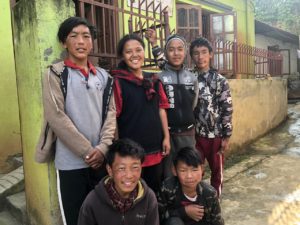Current Projects
- Komang Primary School
- Himalayan Komang Home
- Old age Home
- Retreat Center
- Komang Monastery
Komang Primary School
Komang Primary School is also known as Shree Shayid Dhasard Chand Primary School (the name given by the Nepali government). It is a primary school where children receive education from nursery level to class five. Komang School is a wonderful ideal place to get basic education for Komang's children.
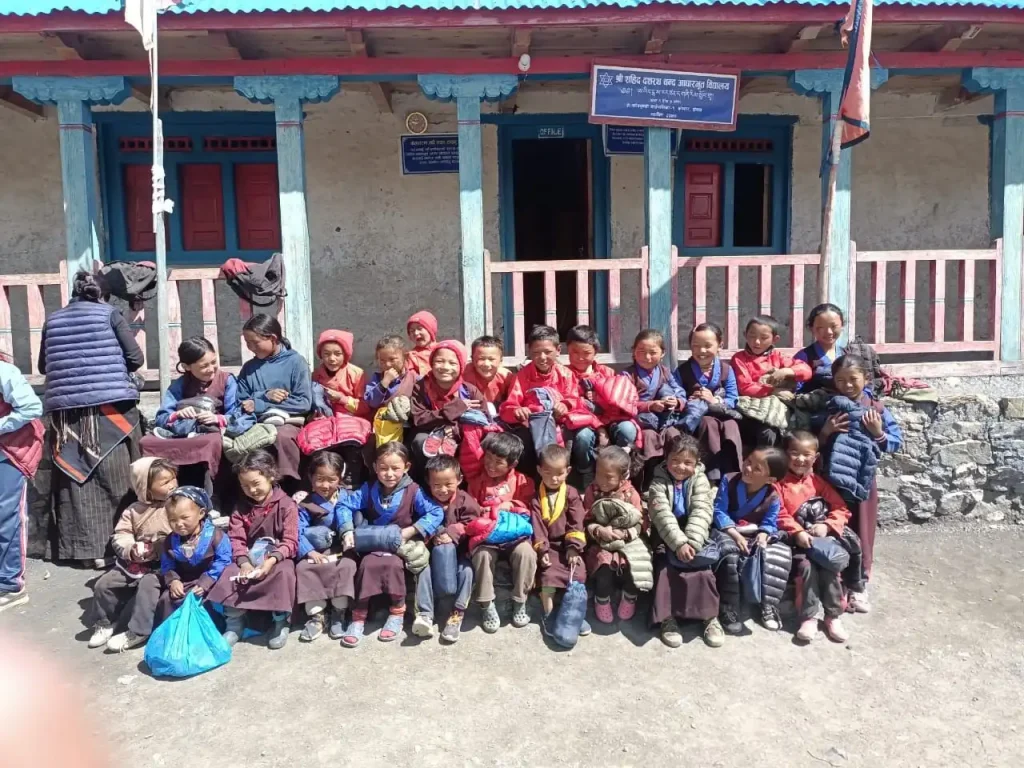
History and timeline of the project
Komang Primary School was founded by Komang Tulku Rinpoche with the help of Christophe Carpenter who created the french organization called LCDP. The school was a community project built by all the villagers together in 2008.
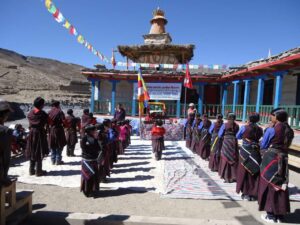
The school ran very smoothly till 2009. That year, our dear Christophe, the main supporter of the French Organization tragically left this world in an accident in Pokhara. Thanks to the help of the other members of LCDP the school kept running but not as before.
After that, Tripod of Koma an NGO from Sweden started helping Komang school, and then Altitude Project (from Canada), and some kind donors like Jerry, David, Hildegard, Peter Werth III, Vanni, and Shwdzhong also help us quite often. Thanks to their generosity and kindness, the Komang Primary School is running well nowadays with 32 students, 6 teachers, and 1 cook.
How do we use the donations?
The donations that we received for Komang Primary School are used for paying salaries to the teachers, buying stationery for the year, sports materials, repairing something in the school, school clothes, warm socks, shoes, and so on.
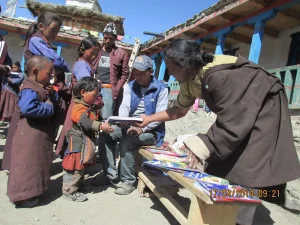
From 2008 till now (2022) Komang School has provided education to more than 72 students. After finishing Primary education, children must move to other places for secondary and higher education. It is not possible for us to open a secondary school in Upper Dolpo because the Nepali government does not allow secondary-level schools for only 30-40 students. Thus, in order to have access to the best education, our children must move to Kathmandu.
In Komang Primary School, the children are taught not only the national curriculum of Nepal, but also Tibetan which is their mother language, history, culture, and basic Dharma teachings. Children receive a modern education, and at the same time, the local culture and ancient traditions are preserved.
Maintenance and improvements
In 2017, Altitude Project provided funds to construct a new toilet block at the school, which was desperately needed. The new block has a separate toilet for girls and boys.
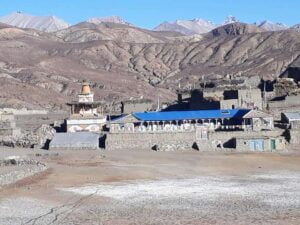
In 2018, with the help of the Nepali Government, the school received funds to install a metal roof over the school. The school was originally built in the traditional way using cham (willow/poplar sticks), stone, and earth to make the flat roof that is typical in the region. In the high desert environment, this method had worked very well, but the changing of the climate has brought heavy, often destructive, rainfall, and a better solution was needed. They chose a blue roof because, in Buddhism, blue symbolizes Peace.
In 2021 with the help of Vanni and many disciples of Komang Rinpoche we were able to finish putting wood on all the floors of each class. This was something very necessary because it can get very very cold inside the school.
The school has a greenhouse that provides fresh vegetables. We also want to plant some trees in the village, especially around the school but till now we are not sure which species can survive here, we tried with willow tree but it didn’t survive.
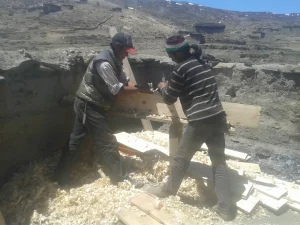
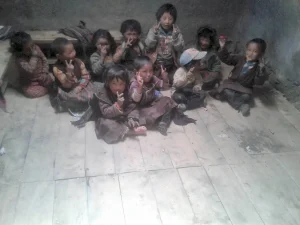
The fruits of compassionate work
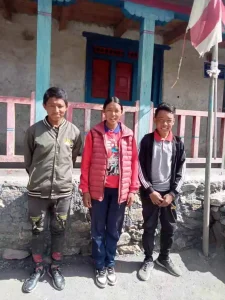
After more than a decade, we are very proud to share with you that one of our students, Lhadon that received their primary education in Komang School and secondary education in Himalayan Komang Hostel is now a teacher in Komang village school.
When students finish class 12 in Kathmandu, they have the opportunity of doing actual teaching training in Komang Primary School. Even the children who finished class 10 level in HKH and go back to the village on holidays often volunteer to help as teachers at the school. They are so excited to share their knowledge with the little ones at their own village school.
We are so happy and proud to see these beautiful fruits obtained thanks to the kindness and compassion of all the Komang School and Himalayan Komang Hostel supporters.
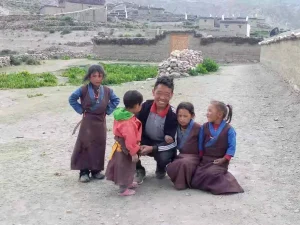
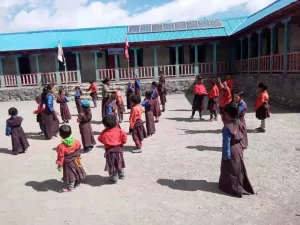
Komang Primary School calendar and events
So what more is going on in Komang school?
- Our school starts in April. In the beginning, we do prayers and dharma rituals with lamas and older people for the swift school academic year, long life and happiness of our sponsors, for the parents' wellness, and for all being's good health and removal of obstacles.
- We do have 2 exams; a half-year exam and a final exam. After each exam, on the result day, all the villagers celebrate together in a festival; children do dances and sing, there are games, and even villagers participate in playing chair games, etc. It is a very happy fun day.
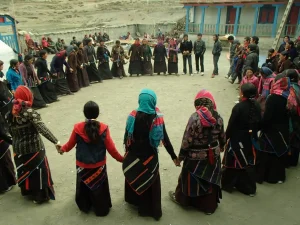
Round dance during a festival day at Komang School - We celebrate the birthday of His Holiness the Dalai Lama, and the Buddha Jayanti. On the Buddha’s birthday, all the villagers and school members get together, they all go to the monastery and get blessings. Then they walk around the whole village with flags, and statues of the Buddha, while the monks perform dharma rituals all the way. We all eat lunch together at school and then join in a local round-dance till evening.
- All the school members' meetings during the year are held there; there are teachers' meetings, teacher parents meetings, etc
- These are the main activities which are held in the school. There are always small community events going on that are not part of the school program, like flag offering programs, rituals, etc.
- Basic literacy skills are taught to villagers during the after-school hours. They often have 20 students that are eager to learn to read and write, aged 20 to mid-40s most of them are women.
Himalayan Komang Home
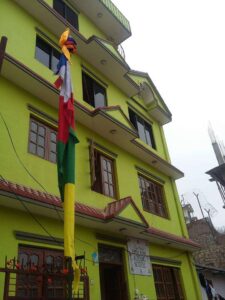
The Himalayan Komang Home (HKH) project was created with the aim of facilitating secondary education for children and adolescents from the Upper Dolpo region, mainly from the town of Komang, in northwestern Nepal. They are Nepalese of the Gurung and Lama ethnic groups of Tibetan culture and Buddhist religion.
The Komang primary school only teaches up to grade 5. To have access to secondary education, boys and girls between the ages of 11 and 12 must travel to Kathmandu, where they can receive a quality education that will allow them in the future to help the development of their people.
In November 2013, thanks to the collaboration between Dolpo Komang Rinpoche (from the Tibetan-Nepali NGO "Dolpo Komang Tulku Association" and Arantza & Anton (from the Spanish NGO "CIDEN"), a student residence called "Himalayan Komang Home" was created. The HKH provides accommodation and all the basic necessities for the students and it is located in the vicinity of the Boudha stupa, a very important place of Buddhist pilgrimage.
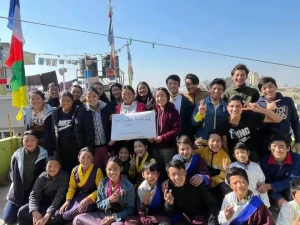
The residence currently has 26 students between the ages of 12 and 18, a cook and the director Nyima Bhuti. They all come from the same village, which helps to maintain a sense of community and culture. Living together is a very important factor to mitigate the cultural shock of arriving from a remote village of a few hundred inhabitants in the Himalayas to a big city like Kathmandu of more than 1 million inhabitants.
Nyima is in charge of managing all the expenses of the residence, all the administrative matters, giving Tibetan classes, helping all the students (especially the younger ones) with their homework, and taking care of them when they are sick. She does everything with great love and compassion for all boys and girls always with a big smile. Currently, in rotation, one of the oldest boys or girls is in charge of cooking for all the others. For them it is a new experience, a way of acquiring responsibilities for their future and they are very happy because it is their first salary!.
The students go to schools near Boudhanath where they learn Nepali, English, natural sciences, mathematics, environment, social sciences, health, sports, etc. At the HKH thanks to Nyima's dedication, they learn to write and read Tibetan, and they pray every morning and every night. They also have the opportunity to receive Dharma teachings from different lamas, Khenpos, Lopon, etc, about love and compassion, peace, the root of the Dharma, etc. Thanks to the volunteers who come through the Spanish NGO "Tumaini", they also learn other languages such as Spanish, learn to play instruments, and many other activities. They have created a program where every weekend they practice "public speaking" in different languages (Nepali, Tibetan, and English), in this way they gain confidence in themselves.

This great family that is the HKH is sustained thanks to the generosity and support of many godfathers, godmothers, and donors through two main NGOs: "Tumaini" (Spanish NGO) and "Blütenherzen Kinderhilfe e.V." (German NGO).
The current costs for the sustainability of the HKH are:
- With three euros a day, €90 per month, the basic expenses of maintenance, education, and health of a student are covered.
- With €30 per month, you cover the food costs of a child
- With €30 you cover the education costs of one boy or girl per month.
Financing these expenses by the families of the students is just impossible as they struggle to make a living through subsistence farming and herding. The education of the children in their village is very complex because they are in a very remote area without almost no support from Nepalese institutions.
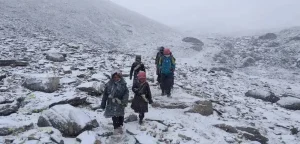
To reach Kathmandu is a very hard and long journey; it takes one week walking to the nearest road from the village of Komang and then another week on local buses to Kathmandu so when the children arrive at HKH they remain for years without seeing their families.
All the students are very bright and highly motivated; most of them want to return to their village to help as teachers, engineers, and health professionals. When they finish their high school studies (class 12) and return to their village they have the skills to open businesses such as restaurants, cafes, craft shops, selling homemade products such as yak cheese, etc. They can also be primary school teachers and even work in a bank. After secondary school, they can also prepare for government exams to be a writer, teacher, office assistant, government official, etc.
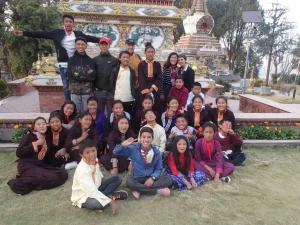
Unfortunately, since the cost of university is very high in Nepal, only the students who manage to get a good scholarship can continue studying at the university. Some students are choosing to do professional training in engineering, architecture, health, electricity and mechanics, etc. These are 3-year studies starting in class 11, so they only need to study one more extra year after class 12. Paying for vocational training is more accessible economically, they have 1 year of internship and more job opportunities after finishing their studies.
Komang Old-age Home
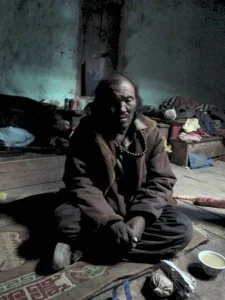
In 2015 all the members of Dolpo Komang Tulku Foundation expressed their concern about the situation of the old people of our village. Because their daughters and sons had to work in the fields all day long, they couldn’t properly care for them. Their elder ones had to be left alone at home the whole day, often they didn’t eat properly, and their families working in the fields would constantly worry about them.
To address this problematic situation in 2016, with the help of the Spanish NGO CIDEN, we decided to create a home for the old-age to improve the living conditions of our village elders.
The project consisted in buying a house in Komang village for the use and enjoyment of the elderly. This house has 2 dormitories, 1 kitchen, and 1 storehouse. In this old-age home we provide meals; like thukpa (Tibetan soup), rice, and tsampa (barley flour), together with warm clothes for winter, blankets, and some medicine to treat minor illnesses.
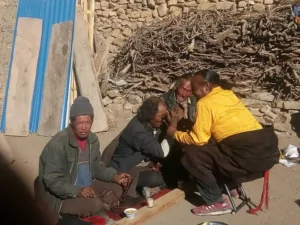
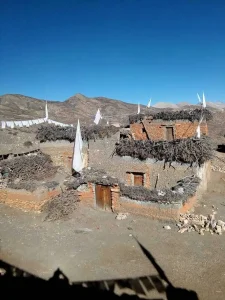
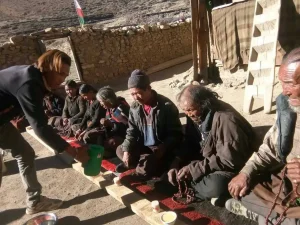
-
For some time 8 elder people (5 women and 3 men) between 60-70 years old used to live at the Old-age Home. They would stay for around eight months, from the end of March till the middle of November. This way their families could work in the fields without worrying about them. Then, during wintertime, as there is no field work, they would go back to their own home to stay with their relatives.
All the elders of Komang are very thankful for this initiative to offer them a place to be together and provide them with the necessary food and health care. Nowadays most elder people are sleeping with their families in their own homes. After seeing how others take care of their old parents, the families seem more attached to them. Currently, the main use of Komang Old-age Home is to provide a space where elder people can go anytime they want to rest, sleep, eat, talk to each other, pray with their mani-wheels, etc.
Further, both the old people and their families now have the peace of mind of knowing there is a place in the village where they can live in case something happen to their daughters and sons and cannot take care of them anymore.
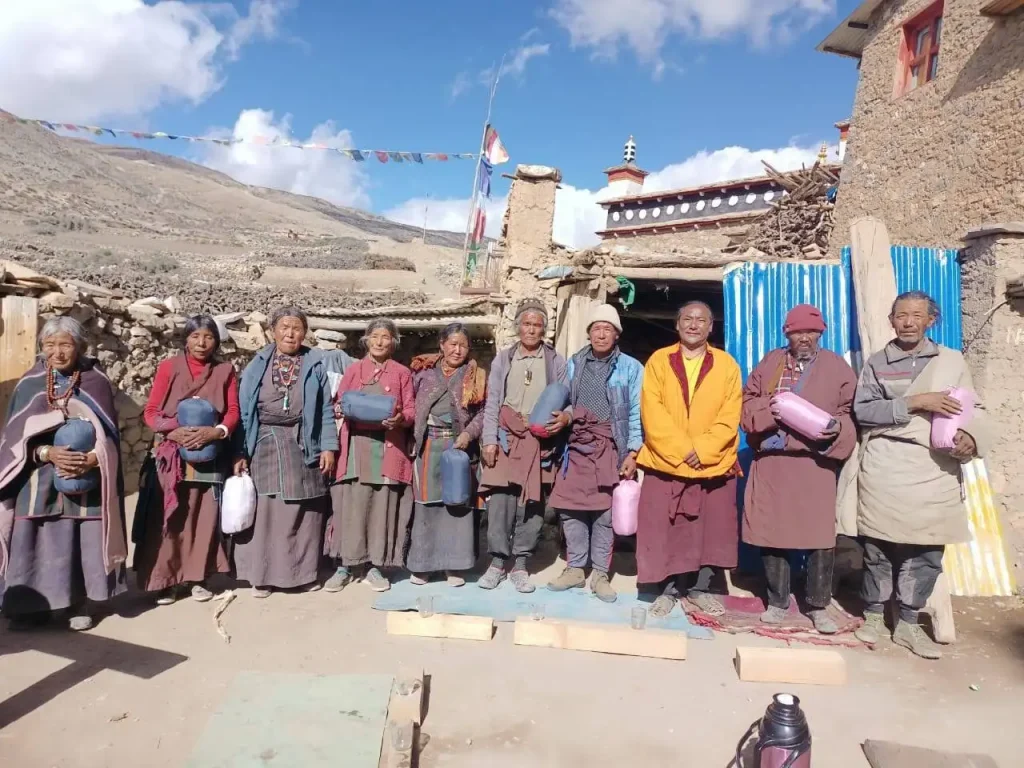
In the future, we have the ambition to support the Old-age Home with the income generated from the retreat center. However as we haven’t found yet people interested in coming to do a retreat there, we still have difficulties supporting them. Every year Komang Rinpoche does his best to provide clothes, food, and other needed things to the old people of the center, but more help is still needed.
In addition and to further support the Old-age Home, we have built a greenhouse to grow vegetables for the people staying at the Home and the retreat center.
Komang Retreat Center
In 2016 we built a retreat center with the help of the Spanish NGO CIDEN. The idea behind the project is to create a suitable place for Dharma practitioners coming from far away who want to do dedicated retreat practice in remote places in the Himalaya mountains and meditate near Komang Tulku Rinpoche.
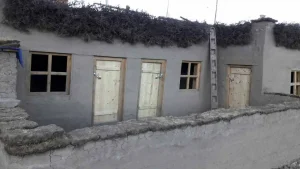
The retreat center is located in the east part of Komang village, near the Komang monastery. It has 1 kitchen and 2 rooms with windows and there is a little common space in front of the center. The rooms are homely with a bed, some shelves, and one table. The center has a solar panel and a battery for providing light to all rooms.
At the moment it is not used as a retreat center because people from outside haven’t come for retreat yet and villagers have the monastery to do retreat.
During lockdown in 2020, villagers used it as a place for quarantine also when someone comes to the village in an emergency they can stay in the retreat center. Lay people also use to cook in the kitchen for having their meals after practice.
Nowadays as still is not used as a proper retreat center, lay people from Komang have space for practicing Dharma. On special days like Guru Rinpoche day (10th day of each month), Dakini day (25th of each month), and 15th of the month (full moon) lay practitioners would use it for reciting mantras, praying, meditating, and so on.
Currently, there is a person in charge of maintaining the retreat center, removing the snow in winter, and taking care of the rain in the rainy season.
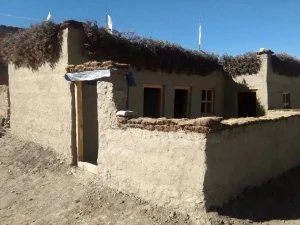
Komang Rinpoche supports the retreat center by providing food and winter clothes. Sometimes the villagers from Komang also offer tsampa, butter, rice, flour, etc. All of them are happily sharing the food and the space.
Future practitioners interested in meditating in the Komang retreat center will contribute to the self-sustainability and maintenance of the Old-age Home, helping with the supply of food and other necessities. The potential tourist attraction of the retreat center has also increased thanks to the reconstruction of the Komang village monastery in 2016.
Komang Monastery Renovation
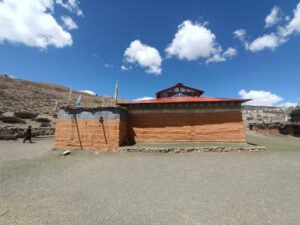
In 2016 with the help of the Spanish NGO CIDEN, we undertook the long overdue renovation of Komang monastery (Thekchen Jangchup Choeling monastery). The roof was in very bad condition and during winter and monsoon rains water would leak inside and damage the valuable paintings.
In our Buddhist tradition, the monastery is a very important cultural and religious element, all the activities of the village run around the monastery. The monks belonging to the monastery perform many community festivals and ceremonies with the people from the village. On the other hand, the monastery is a tourist element of great importance for Tibetan Buddhism.
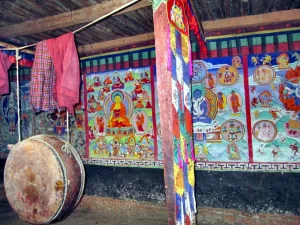
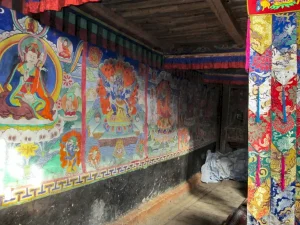
History of the Monastery
The monastery is located in the west of Komang village and was built 767 years ago. At that time around 60 monks used to live in the surroundings of the monastery doing prayers and helping the community. Nowadays around 15 monks are living around the building, but the reconstruction of the monastery has favored the return of the monastic community to its hometown. Since its initial construction, it has been rebuilt two other times; the second time was 65 years ago, and this 2016 rebuilt has been the third in its history.
This work has revitalized the daily life of the village because Komang monastery has great significance in the cultural, historical, and religious heritage of our village and the region of Dolpo.
The works carried out for the reconstruction of the monastery have been the following:
- Most of the original structure of the monastery had collapsed except for the base.
- The reconstruction of the monastery began using stones and mud.
- The roof was rebuilt with wood and aluminum sheets, to completely prevent the entry of water into the monastery.
- In the inner part of the monastery, the people of the village proceeded to rehabilitate all the paintings.
By completely restoring Komang Monastery we have increased Komang's tourist appeal. We hope this work will help to make other current and future projects more sustainable by drawing more interest to our village and our people.
This has been a real community project as one person from each household of the village has actively participated in the reconstruction of the monastery and the retreat center. Many people worked in the transport of the wood and in the extraction of all the necessary stones for the constructions.
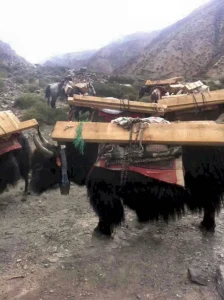
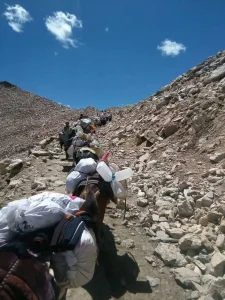

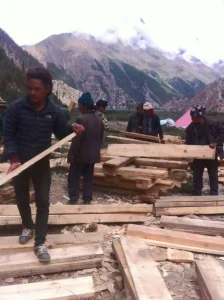
.
The entire population of Komang has been aware from the beginning of the importance and scope of these three major projects. On the one side, the reconstruction of the monastery which is fundamental in the daily life of the entire population, and on the other the creation of a Home to care for the elderly supported by the income generated from the use of the new meditation retreat center. These last two, Old-age Home and Retreat Center hopefully, will become self-sustaining in the near future.
The budget that we had to finish the three projects (retreat center, old age home, and reconstruction of Komang monastery) unfortunately wasn't enough. Then the villagers of Komang decided to sell part of their crops as a contribution to successfully completing the entire project.


